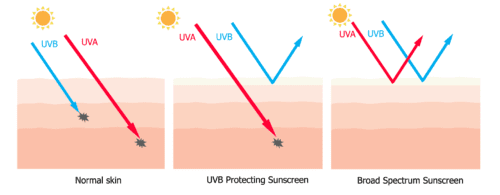The weather has warmed up, summer has almost arrived, and many of us are spending more time outdoors. My family looks forward all year to summer activities, many involving a lot of time in the sunshine. Sun protection should be part of a daily routine, perhaps most importantly during these summer months when our sun exposure increases. In this installment of “Integrate Your Health”, I am going to focus on sunscreen: its purpose, how it works, and what to look for and perhaps avoid when shopping for your products.
The sunshine we love so much arrives from the sun as a spectrum of light. Part of that spectrum is ultraviolet (UV) light. UVA and UVB are the wavelengths of that light that can reach us here on the ground. Unfortunately, overexposure to UVA and UVB can damage our skin, causing sunburn, skin aging, and skin cancer.
Sunscreen is part of a good regimen for sun protection, working to absorb or block UV rays. Two important things to look for in your sunscreen are that it has broad-spectrum coverage and an appropriate SPF. Broad-spectrum coverage means that both UVA and UVB rays are blocked. UVB is the wavelength that causes sunburns, but UVA can penetrate deeper into the skin and cause more subtle damage. Choose a product that has good protection against both UVA and UVB. SPF (sunburn protection factor) is a measurement of how much UVB is blocked. For example, a product with an SPF of 30 will block 97% of the sun’s UVB rays. The higher the SPF, the more UVB protection; however, higher SPFs don’t necessarily protect from damage that can occur from UVA rays. It is also important to note that a higher SPF does not mean you can safely be in the sun for longer when wearing it. It does not appear that an SPF greater than 50 confers additional benefits, and it may give people a false sense of security. Look for a product with broad-spectrum coverage and an SPF of at least 30, and reapply frequently regardless of the SPF.
The active ingredients in sunscreens fall into two basic categories: physical (those that deflect the UV rays) and chemical (those that absorb and scatter the UV rays). Examples of physical barriers are the minerals zinc oxide and titanium dioxide. Examples of chemical filters include oxybenzone and avobenzone (there are many others). Some chemical sunscreens receive bad press because of potential negative health effects, and we are seeing the physical sunscreens more readily available.
As with any skin care products, we should be educated about the ingredients. Some of the ingredients in these products may pose health risks. Chemical sunscreens are more likely to cause allergic reactions. Since they are absorbed in the skin, they can potentially have unintended consequences in the body. An example of such an ingredient is oxybenzone. Oxybenzone is an active ingredient in the majority of chemical sunscreens and it is thought to be an “endocrine disruptor”. That means that once absorbed, the chemical can mimic your hormones in the body and disrupt a natural balance. Because of this possibility, organizations such as the Environmental Working Group recommend that consumers avoid sunscreens containing oxybenzone. Other possible endocrine disruptors to look out for in skin care products are parabens and phthalates. Concerns for these chemicals should not lead you to dismiss sunscreen altogether, but rather make wise choices about the sunscreens that you use. Two helpful websites full of information about product ingredients and safety are Good Guide (www.goodguide.com) and EWG’s Skin Deep Cosmetics Database (www.ewg.org/skindeep).
Many people are using spray sunscreens because they have made the application of sunscreen easier and less messy. I admit to loving the ease of a spray sunscreen, but sadly it comes with some risk. Inhalation of the ingredients can occur and we simply do not know the implications of inhaling these products. They also may not provide a thick enough covering of sunscreen, leaving us more exposed to UV light than we think.
Sunscreen is just one part of good sun protection. There are many other things we could and should be doing to protect our skin. Seek out the shade and avoid sun bathing. Absolutely stay away from the tanning bed. Wear protective clothing when outside like hats and long-sleeved shirts. Reapply your sunscreen frequently, including after you have been in the water. The summer months are so much fun here in Louisiana. While we all enjoy the warm sunshine, remember to take the necessary precautions to protect your skin.


Dr. Nicole Cotter is a rheumatologist practicing medicine in Shreveport, Louisiana. She graduated from LSU School of Medicine in Shreveport, did her Internal Medicine residency at Baylor College of Medicine in Houston, and has completed fellowships in Rheumatology at LSU and Integrative Medicine through the Arizona Center for Integrative Medicine. Dr. Cotter believes that an integrative approach to health is ideal. When not in clinic, you can find her reading, running, cooking with her husband or chasing her two kids.









